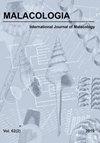Review of the Genus Habeas from Brazil, with Description of Four New Species and in Which Anatomical Features Revealed That They Belong to Urocoptidae (Eupulmonata, Stylommatophora)
IF 1
4区 生物学
Q4 ZOOLOGY
引用次数: 2
Abstract
ABSTRACT South American land snails are relatively poorly known, but their taxonomic relationships can be illuminated with the help of detailed anatomical descriptions and comparisons. The genus Habeas Simone, 2013, species of which are associated with caves, was tentatively described in the prosobranch family Diplommatinidae. Recently collected samples that permitted anatomical investigation, revealed that Habeas actually belongs to the eupulmonate family Urocoptidae. The genus is thus reviewed, including the three so far known species: H. corpus, H. data and H. priscus, all Simone, 2013. Four new species collected in Brazil are described: Habeas lekolus (from Cônego Marinho, Minas Gerais), H. peruassus (from Januária, Minas Gerais), H. lapensis (from Bom Jesus da Lapa, Bahia) and H. claudus (from Cocos, Bahia). Anatomical description is based on H. lekolus, revealing in its most interesting features, the absence of the ureter, presence of a pallial gland, lack of anterior duct to digestive gland, small penis and epiphallus, and absence of bursa copulatrix. Species in this genus usually inhabit cave habitats and are only found in Bahia (BA) and Minas Gerais (MG) Brazilian states, in areas close to São Francisco River. A brief discussion of the family attribution to Habeas is also performed. The present seven species in a genus recently discovered in a relatively small area demonstrate how weak the knowledge on the Brazilian malacofauna is.巴西Habeas属述评及四新种的解剖特征及属尾足科(eupuulmonata, Stylommatophora)
南美洲的蜗牛相对来说鲜为人知,但它们的分类学关系可以通过详细的解剖描述和比较来阐明。Habeas Simone属,2013,与洞穴有关的种,暂定在吻鼻科外交科。最近收集的样本允许解剖调查,显示Habeas实际上属于eupulmonate家族尾足科。因此,对该属进行了综述,包括迄今为止已知的三个种:H. corpus, H. data和H. priscus,均为Simone, 2013。描述了在巴西收集到的4个新种:Habeas lekolus(来自Cônego Marinho, Minas Gerais), H. peruassus(来自Januária, Minas Gerais), H. lapensis(来自Bom Jesus da Lapa, Bahia)和H. claudus(来自Cocos, Bahia)。解剖描述是基于H. lekolus,揭示了其最有趣的特征,没有输尿管,有一个苍白腺,没有通往消化腺的前导管,小阴茎和附睾,没有性交囊。本属的物种通常栖息在洞穴栖息地,仅在巴西巴伊亚州(BA)和米纳斯吉拉斯州(MG)发现,在靠近奥弗朗西斯科河的地区。对人身保护令的家庭归属也进行了简要讨论。最近在一个相对较小的地区发现的一个属的7个物种表明,对巴西malacofauna的认识是多么薄弱。
本文章由计算机程序翻译,如有差异,请以英文原文为准。
求助全文
约1分钟内获得全文
求助全文
来源期刊

Malacologia
生物-动物学
CiteScore
2.00
自引率
0.00%
发文量
15
审稿时长
3 months
期刊介绍:
Malacologia publishes papers on all groups of the Mollusca. Malacologia specializes in publishing long papers and monographic treatments. Complete data are especially appreciated. Papers must be of interest to an international readership. Papers in systematics, ecology, population ecology, genetics, molecular genetics, evolution and phylogenetic treatments are especially welcomed. Also welcomed are letters to the editor involving papers published or issues of import to science of the day.
 求助内容:
求助内容: 应助结果提醒方式:
应助结果提醒方式:


